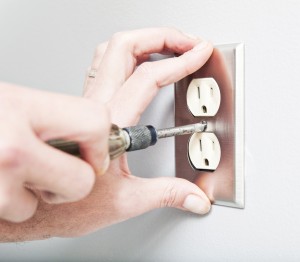
No matter what time of year, whether it’s the holidays, full of bright decorations covering every inch of your home, or summertime, when you just can’t seem to plug in enough fans to keep cool, it’s never the wrong time to talk about electrical overloads — and how to prevent them, spot them, and fix them.
Prevention is simple — don’t overuse extension cords when powering your home. It’s easy to grab one when you’ve run out of outlets; we are all guilty of plugging in too many lamps, chargers and other electronics into those convenient extension cords.
Relying too heavily on extension cords may mean that your home doesn’t have enough outlets. Instead of grabbing an extension cord for a temporary solution, you should call a qualified electrician who can install more outlets.
Major appliances, like your refrigerator, should always be plugged directly into a wall outlet. Never use extension cords or multi-outlet converters for these larger appliances. Extension cords should be used as a short-term option, not a long-time fix.
So why is this a big deal? An overload occurs when the home draws more electricity than a circuit can safely handle. Electrical circuits are designed to handle a limited amount of electricity. When it receives too much, it causes the circuit breaker to trip, shutting off the power to the entire circuit. If there were no breaker in the circuit, an overload would cause the wires to overheat and start a fire.
“It’s way too easy to plug in too many devices onto the same circuit,” said Tom VanParis, CEO of Indiana Electric Cooperatives. “Everyone has a role — whether it’s the cooperative keeping consumers informed, or homeowners doing their research — to best keep their home safe.”
Here are some easy ways to spot an overloaded circuit:
- Flickering, blinking or dimming lights.
- Outlet switch covers that are warm to the touch.
- Burning odors from outlets or switches.
- Frequently tripped circuit breakers.
- Crackling, sizzling or buzzing receptacles.
- Mild shock or tingle from appliances, receptacles or switches.
- Power tools, appliances or electronics that seem to lack adequate power.
Once you know how to spot an overload, it’s a quick fix that consumers can manage themselves. Simply locate your circuit panel, usually found in the basement or a garage in most homes, and check to see if any of the switches in the panel have been tripped or partially tripped. Then turn them off and back on again.
Indiana’s electric cooperatives recommend all consumers map their home’s circuits. It’s as simple as grabbing a notepad and a pencil. This will ensure you are not loading too much on one circuit. Knowing what is on each circuit could help you navigate an overload in the future.
Source: Electrical Safety Foundation International
Mapping your home’s electrical system
Whether you draw up an intricate floor plan of your home or just make a simple list, it’s a good idea to map out your home’s electrical system. Getting to know your home can help you or an electrician if there is an overload.
- Go to the breaker box — usually found in a basement or garage — and turn off one of the breakers that is stamped with a 15 or 20 at the end of the switch. Be sure to note where circuit lies on the panel.
- Walk through the house and try all of the lights, ceiling fans and plug-in appliances. Your electrician should have labeled all of the circuit areas, but there could be outliers they may have missed — like the outlet that powers your blender on the garage lighting circuit.
- Write down everything that doesn’t have power and note which room you’re in. If you want to get really specific, plug a light into each outlet and record all the ones that don’t work.
- Turn the breaker back on and continue down the electrical panel — yes, it’s that simple!
Source: Electrical Safety Foundation International
How to prevent an electrical overload
- Move plug-in appliances to a circuit that is less used with the help of your home circuit map.
- Plug major appliances, like refrigerators, directly into a wall outlet.
- Do not turn on too many things at once. For example, turn off the TV while you vacuum (you can’t hear it anyway).
- Replace incandescent or halogen light bulbs with energy-efficient LED bulbs to reduce lighting loads.
- Power strips only add additional outlets; they do not change the amount of power being received from the outlet.
- Have a qualified electrician inspect your home. A heavy reliance on extension cords could indicate that you have too few outlets.
Source: Electrical Safety Foundation International




